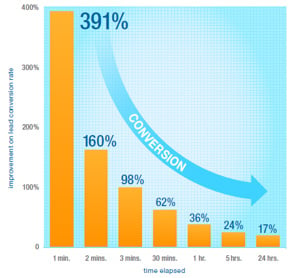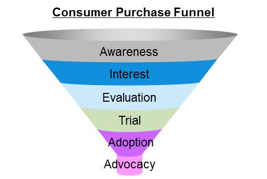Seven Common Mistakes Solar Installers Make
Getting homeowners to go solar is difficult — to say the least. It's expensive and time-consuming, and it's hard to predict who will go solar — and why.
We're here to reduce this cost and clear up the mystery.
The Department of Energy SunShot Initiative funded a three-year, big data project led by NREL to understand why some customers go solar and why so many more don't. NREL has been working with behavioral experts and solar professionals for more than a year. And we've uncovered several insights.
We haven't yet found a way for you to close every potential customer. But we have identified the seven most common mistakes that may be keeping customers away.
1. Not Following Up With Leads Fast Enough
In marketing geek-speak, a lead is "someone who has an articulated interest in" a product – in this case, residential solar. In common speak, it's someone who raised his hand to learn more about solar. Not only is such interest rare, but it's also fleeting. The interest is usually triggered by an event (e.g., sticker shock from an electric bill, seeing an ad, referral from a friend, buying an electric vehicle, etc.) but subsides quickly thereafter. The further removed the event, the less likely the lead will go solar. (Think of those New Year's resolutions to eat healthier or exercise more and how follow-through on those ambitions declines the further we get from January 1). Quick follow up is thus critical.

Analysis by Velocify Research on over 3 million leads indicates that lead-to-sale conversions improve by nearly 400% by contacting customers within a minute after the lead is generated (i.e., interest articulated). Conversion drops rapidly afterward – only improving by 17% if the lead is contacted within 5-24 hours. However, businesses contact leads on average a day after generation, and many allow several days to pass before first contact. The result: most leads are lost before getting any quote at all.
2. Assuming the Customers Share Your Opinion About Solar
Salespeople who are excited about their product are more persuasive. And there is a lot to be excited about when selling solar. It saves money. It provides clean energy. It can help with national energy independence, and so on. However, excitement has its downside.
Your excitement can prevent you from understanding the customer's perspective. What may be a "no-brainer" to you can be a very scary proposition to the customer. In an extreme case, customers can perceive solar arrays as ugly, expensive machines that may or may not work or save them money, that can create unforeseen hazards or problems with maintenance, and that are bolted to their home – often people's most valuable possession – essentially forever. Customers will invariably have different perceptions about solar, many of them deviating far from reality. It is important to address the customers' interest in solar as well as their concerns about going solar. By focusing on what you'd like to talk about – e.g., the pluses and minuses of string inverters vs. microinverters – and not what the customer wants to know, you will quickly lose the customers' interest. Remember, interest can disappear quickly.
3. Confusing Customers With Too Many Options
Having options is generally a good thing. So we are doing customers a favor by giving them more options, right?
Not necessarily. Options can be overwhelming, especially when the customer doesn't know much about solar or is only slightly interested in it. Unfortunately, this is the case with most leads. Switching to solar can be intimidating (see mistake #2), and more options can suggest more ways for thing to go wrong. At the very least, they represent more decisions. For a customer who is wavering on whether to go solar, an additional decision can be taxing. Studies have shown that when people are faced with too many decisions, they default to not taking any action or staying with what they know. For a solar prospect, that would mean getting electricity from the utilities.
This does not mean that you should not give customers options. For certain customers, it may be best to recommend an option. Less knowledgeable customers tend to prefer more direction, while more sophisticated customers are more inclined to appreciate a range of choices.

4. Bashing the Competition Before the Customer Is Sold on Solar
Sure, good sale skills mean knowing how to sell against the competition. But doing so when solar prospects are not fully engaged with solar will hurt not just your competitor, but you, too.
In making purchasing decisions, customers go through a series of stages before they buy—from awareness to adoption to advocacy (see figure). Customers go through an "Awareness" and "Interest" phase before seriously considering solar. It is during the "Evaluation" stage that customers weigh their different options, including whether to go with you or a competitor. No doubt, it's tempting to try to get to the customers first by spiking the other guys' offer with some good, old-fashioned F.U.D. – fear, uncertainty, and doubt: "Their equipment is junk. Their financing is a scam. Their work is shoddy." But using scare tactics is more likely to scare prospects from going solar altogether. Most customers are unfamiliar with or misinformed about solar to begin with. Those who get beyond the "Awareness" stage typically have only weak interest and may find solar intimidating (see mistake #2) or the choices bewildering (see mistake #3).
When somebody suggests that choosing poorly could make you worse off than not choosing anything at all, what would you do?
5. Not Asking for Referrals or Asking Incorrectly
Referrals remain the most cost-effective way to acquire customers. Solar companies pay about $500 for each referral – give or take a few hundred dollars. Even a generous referral fee of $1000 (which some companies do offer) is only a fraction of the average customer acquisition cost of $2000 to $4000. These numbers would likely puzzle academic researchers with no experience of selling solar: if referrals are so much cheaper than customer acquisition, why spend so little on referrals and so much on other marketing efforts? Of course, the solar industry's response would be the problem is not the referral fee; the problem is that there are not enough opportunities for referrals. After all, every sales rep asks their happy customers for referrals, right?
Not exactly. In fact, many sales reps do not ask their customers for referrals, or ask so timidly that the ask is the same as not asking at all. Solar pros often request referrals in a passing statement, such as, "Hey Ted. If you ever know anybody who is interested in solar, can you let me know?" To which, Ted replies, "Okay." The sales rep leaves, assuming his request will be top of mind for Ted the next time he sees a friend with a good roof for solar or a high energy bill.
But Ted has many others things to think about. And Ted doesn't actively engage with his PV system the way he engages daily with other devices (like his iPhone or his car). So he is unlikely to think about his PV system on a regular basis. Ted is certainly not going to be as capable as you in identifying a good solar candidate, and he's unlikely to know whether his friends and neighbors have high energy bills. All these factors mean that Ted by himself is probably not going to be your best lead source. So follow up is important. It could be a periodic checkup, a solar party, or a physical reminder, such as a referral card or a gift.
6. Losing Contact With Past Solar Customers
Another good reason to stay in touch with customer Ted is that your past solar customers are arguably your best marketing resources.
One of the biggest barriers to adoption is the lack of "trialability" (yes, a real term in academic literature). Selling solar is difficult because customers cannot try the product before buying. There is no test-driving of solar, no 30-day money back guarantee, or no free sample. The customer faces an all-or-nothing proposition: either you bolt a solar array onto his house or he can't experience it all.
Because they can't try it out for themselves, solar prospects place more weight on the experiences of past customers to inform their decision. The prospects will ask for references among past customers, look at their reviews on social media sites, or read or view their testimonials. The longer the past customers have had solar, the more credible their experiences. These customers can speak to potential long-term concerns about reliability, savings, or maintenance.
Unfortunately, many solar companies lose contact with their customers, especially their earliest customers. Staying in touch with all previous customers – even if only occasionally – can provide you with a wealth of testimonials and the trust they confer on your business.
7. Giving Up Too Soon on Leads or Getting Referrals
It appears that most installers give up on a lead within three months. Attempts to get referrals from customers have only a slightly longer time horizon – perhaps up to six months. A University of Texas study in 2013 found that the average time to adopt (the time when the customer first considered going solar to the time they made a purchase) is nine months. Similarly, we have heard of solar companies getting referrals from customers who had gone solar several years earlier.
There are a lot of opportunities to win a customer or referral after the initial three to six months. The earlier you give up, the more money you might be leaving on the table. Of course, this does not necessarily mean that every lead or every past customer should be contacted continuously for years. What it does mean is that you should be selective about who you contact, and think carefully about how you approach each person.
* Note: Currently, the study is only accepting participants who operate in one or
more of the following states: AZ, CA, NJ, and NY.
Share
Last Updated April 3, 2025
